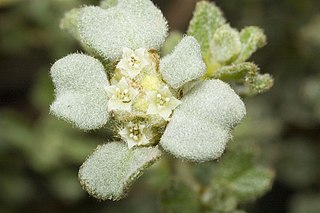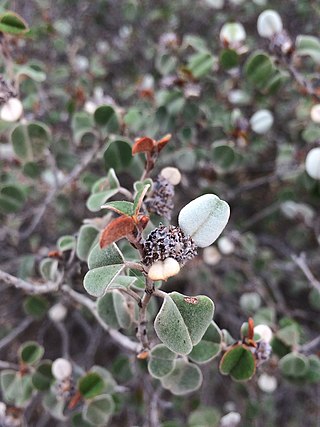
Pomaderris oraria, commonly known as Bassian dogwood, is a species of flowering plant in the family Rhamnaceae and is endemic to south-eastern Australia. It is a compact shrub with hairy branchlets, hairy, elliptic leaves and panicles of hairy, greenish to cream-coloured or crimson-tinged flowers.
Pomaderris briagolensis is a species of flowering plant in the family Rhamnaceae and is endemic to Victoria, Australia. It is a shrub with hairy branchlets, egg-shaped or oblong leaves and panicles of white to rust-coloured flowers.
Pomaderris crassifolia is a species of flowering plant in the family Rhamnaceae and is endemic to eastern Australia. It is a shrub with hairy young stems, egg-shaped or elliptic leaves, and clusters of cream-coloured or yellow flowers.
Pomaderris viridis is a species of flowering plant in the family Rhamnaceae and is endemic to south-eastern continental Australia. It is a shrub or small tree with hairy young stems, egg-shaped to elliptic leaves, and panicles of cream-coloured to pale yellowish-green flowers.

Spyridium bifidum, commonly known as forked spyridium, is a species of flowering plant in the family Rhamnaceae and is endemic to South Australia. It is an erect shrub with densely softly-hairy young stems, wedge-shaped to linear leaves sometimes with a two-lobed tip, and densely woolly heads of white-velvety flowers.
Spyridium coalitum is a species of flowering plant in the family Rhamnaceae and is endemic to Kangaroo Island in South Australia. It is a slender, erect shrub with softly-hairy young stems, oblong to narrowly elliptic leaves, and head of white to cream-coloured flowers.

Spyridium daltonii is a species of flowering plant in the family Rhamnaceae and is endemic to Victoria in Australia. It is a shrub with softly-hairy branchlets, linear to narrowly elliptic leaves, and small groups of hairy, yellowish flowers.

Spyridium eriocephalum, commonly known as heath spyridium or heath dustymiller, is a species of flowering plant in the family Rhamnaceae and is endemic to south-eastern Australia. It is an erect to spreading shrub with linear leaves, and heads of white or cream-coloured, woolly-hairy flowers with brown bracts at the base.
Spyridium erymnocladum is a species of flowering plant in the family Rhamnaceae and is endemic to South Australia. It is a low, woody shrub with linear leaves, and heads of about seven woolly-hairy flowers.
Spyridium fontis-woodii, commonly known as Woods Well spyridium, is a species of flowering plant in the family Rhamnaceae and is endemic to a small area of Coorong National Park in South Australia. It is a slender shrub with softly-hairy young stems, broadly egg-shaped to broadly heart-shaped leaves with the narrower end towards the base, and head of white to cream-coloured flowers.

Spyridium halmaturinum, commonly known as Kangaroo Island spyridium, is a species of flowering plant in the family Rhamnaceae and is endemic to Kangaroo Island in South Australia. It is an erect, sticky shrub with densely softly-hairy young stems, leaves that are heart-shaped with the narrower end towards the base to broadly wedge-shaped or Y-shaped, and dense heads of white to cream-coloured flowers.
Spyridium montanum is a species of flowering plant in the family Rhamnaceae and is endemic to the Stirling Range in the south of Western Australia. It is an erect shrub with elliptic or egg-shaped leaves, and groups of up to ten densely hairy, white or cream-coloured flowers.

Spyridium riparium is a species of flowering plant in the family Rhamnaceae and is endemic to the south of Western Australia. It is an erect shrub, usually with narrowly egg-shaped leaves, and clusters of densely hairy, white or cream-coloured flowers.
Spyridium scabridum is a species of flowering plant in the family Rhamnaceae and is endemic to Kangaroo Island in South Australia. It is a slender, erect shrub or small tree with oblong or narrowly egg-shaped leaves, and heads of sparsely hairy, white to cream-coloured flowers surrounded by densely hairy floral leaves.

Spyridium stenophyllum is a species of flowering plant in the family Rhamnaceae and is endemic to the south of South Australia. It is a sticky shrub with narrowly Y-shaped leaves, and heads of white to cream-coloured flowers surrounded by densely felty-hairy floral leaves.

Spyridium tricolor is a species of flowering plant in the family Rhamnaceae and is endemic to southern continental Australia. It is an erect shrub with broadly elliptic to round leaves, and dense clusters of densely woolly-hairy, cream-coloured flowers.
Stenanthemum divaricatum is a species of flowering plant in the family Rhamnaceae and is endemic to the southwest of Western Australia. It is a small, often spiny shrub with sparsely hairy young stems, fan-shaped to narrowly egg-shaped leaves and densely, softly-hairy heads of tube-shaped flowers.

Stenanthemum emarginatum is a species of flowering plant in the family Rhamnaceae and is endemic to the southwest of Western Australia. It is a spreading to prostrate shrub with sparsely hairy young stems, narrowly fan-shaped to linear leaves and densely, shaggy-hairy heads of white or cream-coloured flowers.
Stenanthemum stipulosum is a species of flowering plant in the family Rhamnaceae and is endemic to inland Western Australia. It is an erect or low-lying shrub with densely hairy young stems, egg-shaped with the narrower end towards the base, and clusters of 10 to 30 densely hairy white or cream-coloured flowers, sometimes surrounded by whitish floral leaves.
Cryptandra triplex is a species of flowering plant in the family Rhamnaceae and is endemic to the north of the Northern Territory. It is a hairy shrub with narrowly elliptic to lance-shaped or egg-shaped leaves and white to cream-coloured or yellowish, tube-shaped flowers arranged singly or in groups of up to 5 in leaf axils, near the ends of branches.










